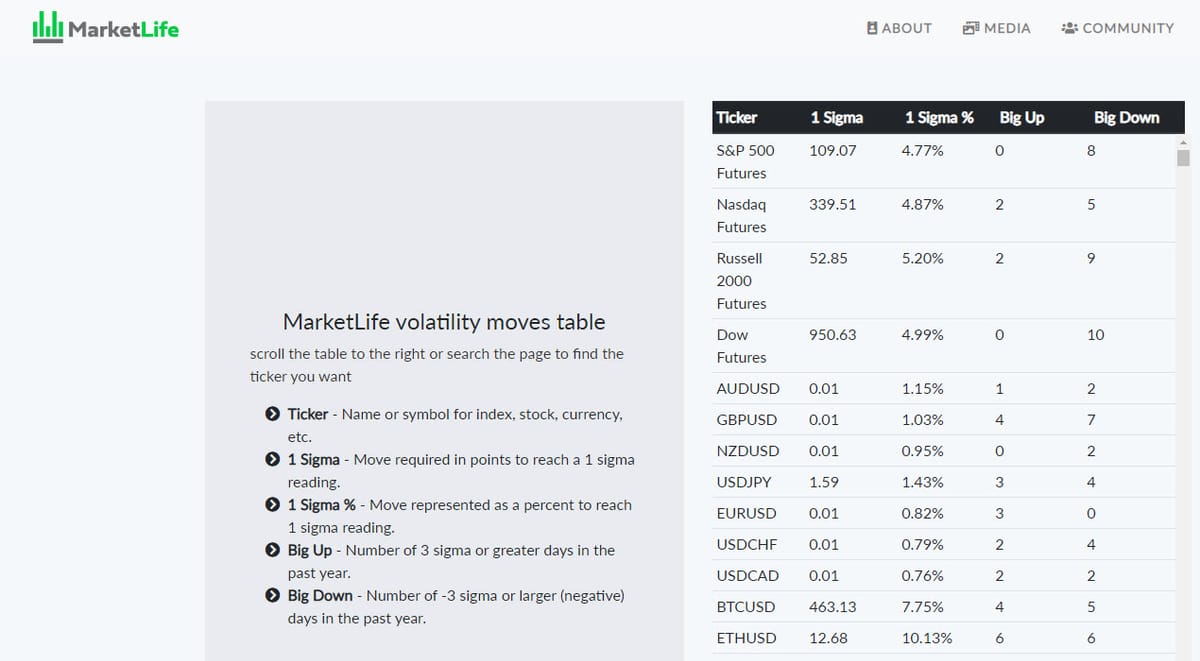A new (FREE) tool to help you

“The benchmark Dow Jones Industrial Average is off nearly 300 points as of midday today…” You can hear a similar quote on nearly every news outlet many times a day, but I’ve always mentally followed up with the same questions: “So what? Is that a lot or a little? Should we care?”
Of course, the commentator doesn’t know, because it’s always reported in the same matter-of-fact tone with no further commentary. It seems that 30,000 or 30 would be reported in exactly the same way!
But, of course, here’s the problem: moves in markets are only meaningful when we consider what “normal” is for that market.
What’s normal?
In the case of the DJIA, if we were in December of 2019, those 300 points might be a big deal. An average day’s move was somewhere between 125-150.
On the other hand, if you’re looking at it today (March 2020), an average move is much bigger—the Dow Jones moves over 1,000 points, on average, from day to day.
Without that baseline, the daily change number, and even the percent change on the day doesn’t really mean much. (For reference, an average day’s percent change in late 2019 was about 0.4% for stock indexes, and it’s over 5% in March 2020!)
Tools to help
Knowing this “baseline” has been a critical part of my thinking in every market since the mid 2000’s—literally every time I look at a market move, I consider it in context of what’s normal.
This was something I wrote about at length in my first book, and you can also find many things I’ve written online under the topic “sigma spikes”. (A google search will be rewarding.)
But still, the average trader hasn’t had a good way to do this. We have created a free page on MarketLife.com that gives “normal moves” for most liquid stocks, major currencies, and important futures markets.
You don’t need to sign in or anything. Just
go hereand get the updated values every day.
From here, it’s pretty easy. For instance, I’m looking at AAPL stock right now, as I write this, which is down -4.3% Is that a lot or not? I go to the table here, look up AAPL, and find that the average (1 Sigma) move for AAPL is 6.3%. So… today’s 4.3% move is less than a normal day, and is probably noise.
Digging deeper
There are four columns on the table. The first gives a “1 Sigma” move (in points) and the second gives a “1 Sigma” move in %. This lets you, very easy, see what is average whether you are looking at the point change or a percent on the day.
The calculation we are using here is something we’ve developed and have been using internally. It is, more or less, standard deviation of daily returns over, roughly, a one month lookback period, but it has some smoothing that makes it respond very well to periods in which volatility changes quickly. (The exact calculation is proprietary, but what you need to know is that it reflects current volatility conditions accurately.)
The last two columns count the number of days that have been +/- 3 sigma over the past year. This gives you an idea if the market you are looking at is relatively stable or unstable. (Hint: option pricing models don’t handle unstable markets very well, and large sigma moves will always cause surprises. You might consider stability before writing options, if selling premium is your thing.)
We hope this tool is useful and helps you keep volatile markets in better perspective!



